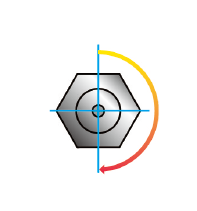SPARK PLUG Installation
Caution
- Always refer to the vehicle manufacturer’s repair manual for specific installation procedures.
- Do not apply screw thread lubricant to the spark plug since it may make you over tighten the spark plug and cause the screw to break.
However, screw thread lubricant is already applied to some plugs for LPG engines. In such case, tighten the plug according to the maintenance manual.
It is necessary to install the plugs in the engine using the correct torque.
- Too low torque: may cause damage to the engine and the plugs due to leakage of combustion gas or vibration.
- Too high torque: may cause airtight leakage or break of the mounting screws due to the the caulking of the insulator and housing become loosened.
Recommended Torque and Tightening Angle
| Thread Size | Applicable Models | Recommended Torque |
Recommended Tightening Angle | |
|---|---|---|---|---|
| New Plug | Previously Used | |||
| M 8 | All Types | 8-10N・m | About 1/3 turn | About 1/12 turn |
| M10 | Types other than the ones shown below | 10-15N・m | About 1/3 turn | About 1/12 turn |
| M10 | UFE, IUH, VUH, VNH Types | 10-15N・m | About 2/3 turn | About 1/12 turn |
| M10 | Stainless Gasket Type ( *1VUH27ES,U24FER9S )
|
10-15N・m | About 3/4 turn | About 1/12 turn |
| M12 | All Types | 15-20N・m | About 1/3 turn | About 1/12 turn |
| M14 | Types other than the ones shown below | 20-30N・m | About 1/2 turn | About 1/12 turn |
| M14 | Stainless Gasket Type ( *2IK16G,IK20G,IK22G,K20PR-U8S, )
K20PR-U9S,KJ20DR-M11S,PK22PR-L11S, SK20PR-N9S,SK22PR-M11S,SKJ20DR-M11S, VK16G,VK20G,VK22G |
20-30N・m | About 2/3 turn | About 1/12 turn |
| M18 | All Types | 30-40N・m | About 1/4 turn | About 1/12 turn |
| M14 Taper seat |
All Types | 10-20N・m | About 1/16 turn | About 1/16 turn |
| M14 (Gas) |
If the cylinder head material is cast iron | 20N・m | – | – |
| M14 (Gas) |
If the cylinder head material is aluminum | 17.5N・m | – | – |
| M18 (Gas) |
If the cylinder head material is cast iron | 30N・m | – | – |
- (*1)VUH27ES, U24FER9S
- (*2)IK16G, IK20G, IK22G, K20PR-U8S, K20PR-U9S, KJ20DR-M11S, PK22PR-L11S, SK20PR-N9S, SK22PR-M11S, SKJ20DR-M11S, VK16G, VK20G, VK22G
- Check the gasket ring.
Caution
When cleaning the mounting seat on the engine side, be sure that oil, dust and foreign objects in the vicinity of the cylinder head to not fall into the engine.
- Hold the spark plug vertically to plug hole and lightly tighten it by hand or by using a plug wrench.


Caution
Use plug wrench that fits to the plug’s hexagonal housing
- Using a plug wrench, tighten the plug to the recommended torque or the recommended tightening angle.

Caution
Be careful not to hold the wrench obliquely.

Caution
Tighten the plug to the recommended torque or the recommended tightening angle.

Insulator Cracking
The spark plugs of recent engines are installed in deep plug holes, and it is difficult to notice the tilted wrench when installing and removing the spark plugs. However, if you turn the wrench in this condition, the head of the insulator may become stuck. By applying excessive force, resulting in cracking.
*The mode of occurrence differs depending on the difference in the structure and the dimensions of the plug hole by vehicle and the type of wrench.


The spark plugs of recent engines are installed in deep plug holes, and it is difficult to notice the tilted wrench when installing and removing the spark plugs. However, if you turn the wrench in this condition, the head of the insulator may become stuck. By applying excessive force, resulting in cracking.
*The mode of occurrence differs depending on the difference in the structure and the dimensions of the plug hole by vehicle and the type of wrench.
